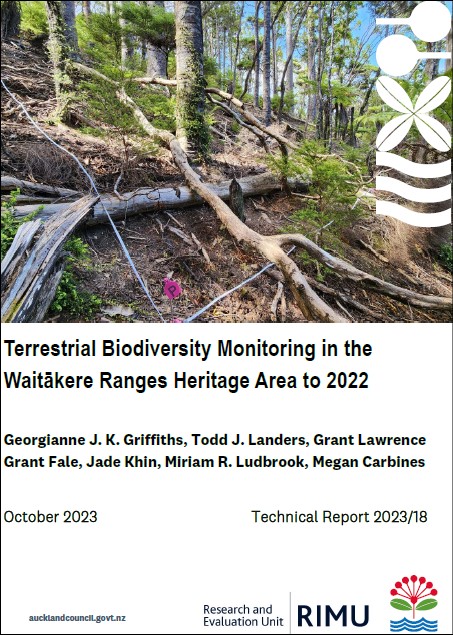Terrestrial biodiversity monitoring in the Waitākere Ranges Heritage Area to 2022
Author:
Georgianne J. K. Griffiths, Todd J. Landers, Grant Lawrence, Grant Fale, Jade Khin, Miriam R. Ludbrook, Megan CarbinesSource:
Auckland Council Research and Evaluation Unit, RIMUPublication date:
2023Topics:
EnvironmentExecutive summary
The Waitākere Ranges Heritage Area Act 2008 recognises the ecological and cultural significance of the Waitākere Ranges which covers approximately 27,000 ha and contains one of the two largest blocks of continuous vegetation in the Auckland region (c. 21,000 ha). The Act requires Auckland Council to monitor and report on the state of the environment within the Heritage Area every five years. This technical report provides empirical analysis on land cover change, and plant and bird biodiversity collected from systematic long-term monitoring of permanent plots in the Heritage Area from 2009 to 2022.
Analysis of land cover, forest canopy cover, and landslides highlight the continued dominance of indigenous vegetation, comprising 81 to 85 per cent (22,000 ha) of the Heritage Area. Forest and scrub/shrubland are the primary land cover classes, occupying 62 per cent and 22 per cent of the land area, respectively. At this broad scale, land cover classes have shown relative stability over a six-year period (2012-2018).
Landslide analysis (of aerial images from 2022) revealed a significant number of landslides (more than 150) in the Waitākere Ranges Regional Park, triggered by intense rainfall in August 2021. These mainly small (average of 0.1 ha) shallow slides and debris flows, have caused vegetation loss, affecting approximately 18 hectares of forest in total. The majority of impacted forest comprises mature kauri-podocarp-broadleaved forest. Satellite images taken after the 2023 Auckland Anniversary Weekend floods and Cyclone Gabrielle show even more extensive landslips throughout the forest but were outside the period of this reporting. They are being analysed for a separate technical report and highlight potential cumulative impacts with increasing rates of intense rainfall triggered multiple-occurrence landslide events in natural forests. Further research and monitoring are necessary to fully understand the causes, ecological processes, and biodiversity impacts of these landslides.
Forest in the Heritage Area continues to recover from widespread earlier disturbance from logging, burning, gum digging and clearance for farming, most of which occurred prior to the 1940s. The most disturbed areas are now in regenerating forest types which make up 42 per cent of the forested area. Areas that were less disturbed or unlogged are classed as warm kauri-podocarp-broadleaved forest and make up 45 per cent of the forest area. Both warm kauri-podocarp-broadleaved forest and regenerating forest are highly diverse, dominated by indigenous plants and following expected successional pathways.
The Heritage Area also supports a diverse range of bird species. The most commonly counted birds were indigenous species, with half of all the birds counted being of endemic New Zealand species. There were significantly fewer introduced species encountered within the Heritage Area compared to many other sites across the region, indicating how important the Waitākere habitat is for supporting indigenous biodiversity. Conspicuousness of indigenous species abundance has increased over the last ~10 years, including rises in the abundance of tauhou, riririro, pīwakawaka, and korimako.
The high ecological integrity of forest and high percentage of indigenous birds, with notable increases in some species, within the Heritage Area arises partly from the large, unfragmented and continuous characteristics of the forest, and from ongoing management to limit weed and pest pressures. There remain areas of concern, however, arising from the current and potential future impacts of pest animals, plant pathogens, weeds, and climate change. Recent extremes in drought and rainfall events generating wilting of some plant species and progressively weakening soils triggering widespread landslides show how rapidly climate change may impact forest processes and emphasise the need to continue working to protect and support the forest ecosystems to continue their own regeneration.
Auckland Council technical report, TR2023/18
October 2023
*****
See also
Waitākere Ranges Heritage Area 2017-2022. Five-year monitoring report
